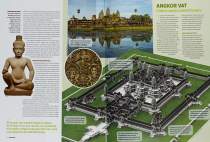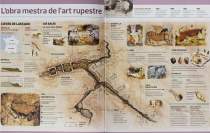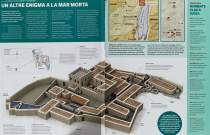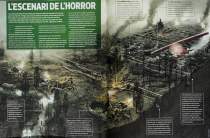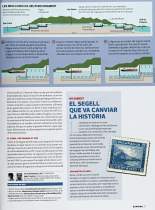Sàpiens
-
Angkor Wat
The temple of Angkor Wat, jewel of the Khmer empire that directed the destinies of Southeast Asia between the 9th and 15th centuries, appeared in the Angkor Vat, l'esplendor khmer (Angkor Vat, the Khmer Splendor), in the Catalan popular historical magazine Sàpiens, which is published monthly. Dedicated to the Hindu god Vishnu, Angkor Wat was built by Suyavarman III, who reigned between 1113 and 1150, and was the capital until Jayavarman VII (1125-1218) moved the capital to the nearby Angkor Thom. Both buildings are located in Cambodia, in the town of Siem Riap. Angkor Wat, considered the largest religious structure ever built, has been a World Heritage Site since 1992, along with the also monumental Angkor Thom ruins.
Page(s): 36-37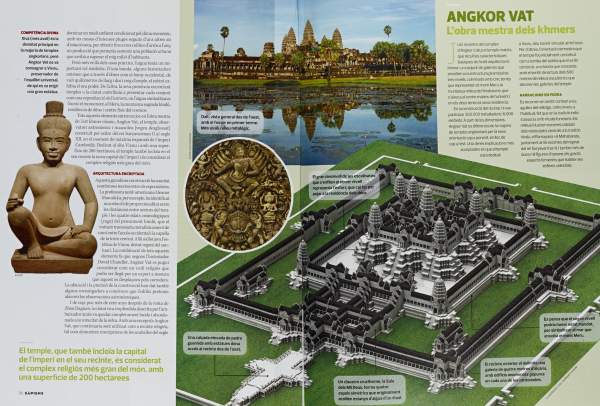
-
Tenochtitlan
Tenochtitlan, the capital of the Aztec empire, illustrated a report entitled Sang per als déus (Blood for the Gods), published in Sàpiens, the historical publication magazine written in Catalan. The information was about the practices of human sacrifice carried out by the Aztecs. Of Nahua culture and language, the Aztec was people of farmers, merchants, and warriors. Settled in the swampy lands of the Valley of Mexico, Aztecs built, between the 14th and 16th centuries, an empire in Mesoamerica that extended through the center of the current Mexican country and reached the Gulf and Pacific coasts.
Page(s): 44-45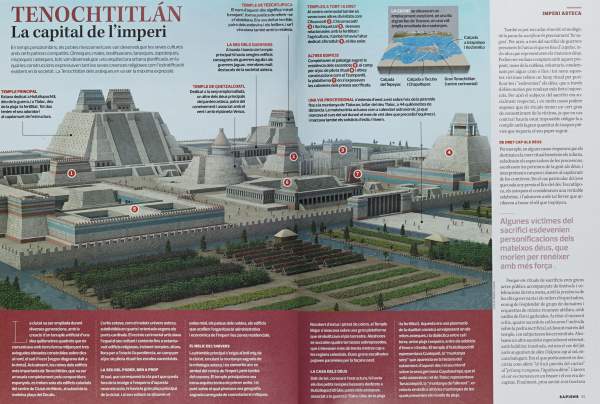
-
Opet Festival
Originally entitled Religious Holidays in Antiquity, the infographic served to illustrate El festival Opet de Tebes (The Opet de Tebas Festival) in a comprehensive report entitled Ser sacerdot a l'antic Egipte (Being a Priest in Ancient Egypt), published in Sàpiens. The Opet festival was celebrated in the city of Thebes, during the annual flood of the Nile. The central ceremony of the festival consisted of a religious procession in which the figures of the god Amun and his family were transported in ritual boats from the sanctuary of Karnak to sanctuary of Luxor. It was a State ceremony, in which participated the pharaoh and his family, the high dignitaries and the court, the priests, the military and the people. The festival of Opet consecrated and commemorated the divinity of the sovereign, as the son of Ammon. The oldest records of the celebration date back to the co-regency of Queen Hatshepsut and Tutmosis III, in the 18th dynasty. The Catalan magazine Sàpiens, which is published every month, is dedicated to historical divulgation.
Page(s): 38-39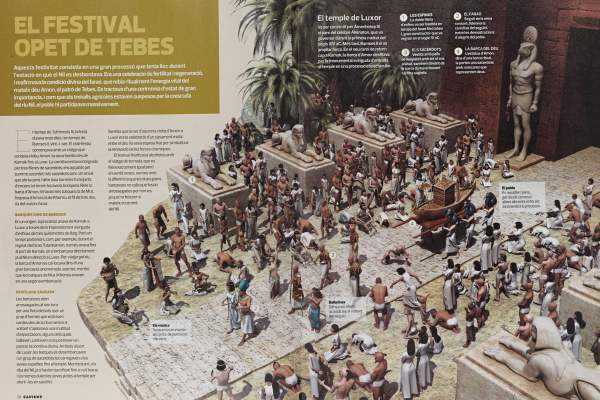
-
Rock Art of Lascaux
Under the title of L'obra mestra de l'art rupestre (The Masterpiece of Rock Art), the popular historical magazine Sàpiens offered the infographic of the Lascaux caves in southwestern France, considered one of the most important representations of rock art. Dated 15,500 years ago, during the Magdalenian period, over 1,800 polychrome paintings of prehistoric fauna (bison, horses, bulls, deer and wild boar) appear on the ceilings and walls of its galleries. The cave was discovered by chance by four teenagers in 1940. In 1963, the French government ordered to close it to the public, since mass visits were deteriorating the paintings. To compensate this, a replica of the cave and paintings known as Lascaux II was built, located 200 m from the original site. Abbe Henri Breuil (1881-1967), a specialist in paleolithic art, was the first archaeologist to describe and investigate these paintings. Lascaux caves were declared a World Heritage Site by UNESCO in 1979. Sàpiens is published in Catalan in Barcelona and is published monthly.
Page(s): data not available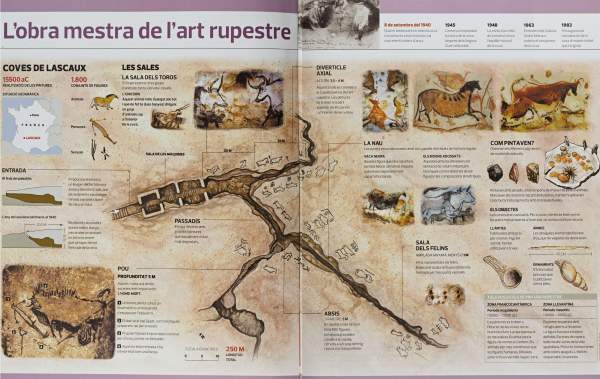
-
Qumran Settlement
The history magazine Sàpiens used the infographic The Ruins of Qumran for its report entitled Israel i els secrets de les ruïnes de Qumran (Israel and the Secrets of the Ruins of Qumran), in which it explained the contents of the manuscripts discovered in 1947 in the caves of the Khirbet Qumran site, in the West Bank region, near the Dead Sea. These texts, written mostly in Hebrew and Aramaic, date back from 250 BC to 60 AC, are reproductions, studies and interpretations of the Bible. The Qumran ruins and the manuscripts are related to the Essene ascetics, Jewish sect contemporary with the emergence of Christianity and which was critical of the official religion. The infographic ideally reproduces the Qumran settlement based on archaeological findings. Sàpiens magazine, published monthly, is published in Barcelona and is written in Catalan.
Page(s): Data not available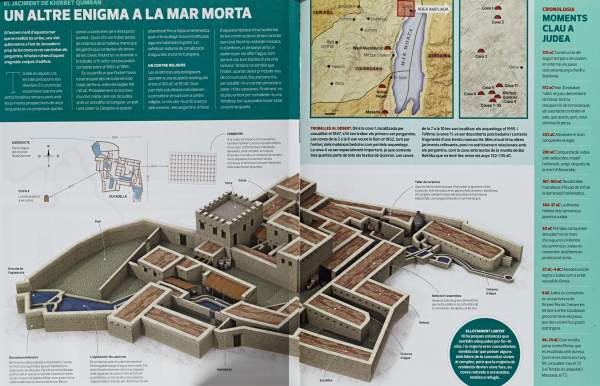
-
Trench War
To commemorate the centenary of the start of the First World War (1914-1918), Sàpiens magazine published a special issue. In its inner pages he illustrated the trench warfare, using an infographic, the type of combat that characterized the conflict between 1914 and 1917. Quite rightly, the client entitled the infographic L'escenari de l'horror (The Scene of Horror). In addition to the trenches, the infographic also contains elements which are unusual in other works on the matter, such as the transport of troops by road with trucks (La Voie Sacrée, which linked the trenches of Verdun with the French rear), the artillery positions and the air force intervention.
Page(s): Not available data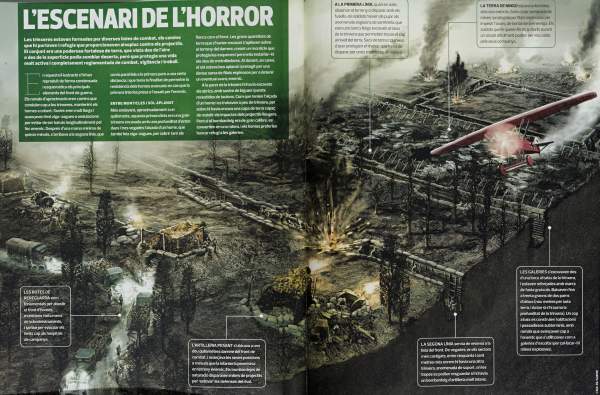
-
Panama Canal Locks
The locks system of the infographic of the Panama Canal was included by Sàpiens magazine in the report dedicated to commemorate the centenary of the entry into service of this naval communication route that connects the Caribbean Sea with the Pacific Ocean. The title of the report: La drecera americana (The American Shortcut) alludes to the fact that was the United States — under the presidencies of William McKinley (1897-1901), Theodore Roosevelt (1901-1909) and the first of William Howard Taft (1909-1913) — who gave the final impulse to the construction of the canal, after the failure in 1889 of the French engineer Ferdinand de Lesseps, builder of the Suez canal. This infrastructure was under the control of the US Administration until December 31, 1999, when Panama regained its ownership. Sàpiens is a monthly publication of historical dissemination published in Catalan.
Page(s): 57

